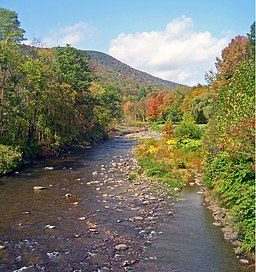Esopus Creek
| Esopus Creek | |
| River | |
|
The Esopus in Shandaken
|
|
| Name origin: Local Lenape tribe | |
| Country | United States |
|---|---|
| State | New York |
| Region | Catskills, Hudson Valley |
| County | Ulster |
| Towns | Shandaken, Olive, Marbletown, Hurley, Ulster, Saugerties |
| Part of | Hudson River |
| Tributaries | |
| - left | Stony Clove Creek, Saw Kill, Plattekill Creek |
| - right | Woodland Creek |
| City | Phoenicia, Hurley, Saugerties |
| Landmark | Ashokan Reservoir |
| Source | Winnisook Lake |
| - elevation | 2,660 ft (811 m) |
| - coordinates | 42°0′56″N 74°24′44″W / 42.01556°N 74.41222°W |
| Mouth | Hudson River at Saugerties |
| - elevation | 0 ft (0 m) |
| - coordinates | 42°4′17″N 73°55′45″W / 42.07139°N 73.92917°WCoordinates: 42°4′17″N 73°55′45″W / 42.07139°N 73.92917°W |
| Length | 65.4 mi (105 km) |
| Basin | 425 sq mi (1,101 km2) |
| Discharge | for Mount Marion, NY |
| - average | 507 cu ft/s (14 m3/s) |
| - max | 65,300 cu ft/s (1,849 m3/s) |
| - min | 5.6 cu ft/s (0 m3/s) |
|
Map of Esopus Creek and its watershed
|
|
Esopus Creek /ᵻˈsoʊpəs/ is a 65.4-mile-long (105.3 km)tributary of the Hudson River that drains the east-central Catskill Mountains of the U.S. state of New York. From its source at Winnisook Lake on the slopes of Slide Mountain, the Catskills' highest peak, it flows across Ulster County to the Hudson at Saugerties. Many tributaries extend its watershed into neighboring Greene County and a small portion of Delaware County. Midway along its length, it is impounded at Olive Bridge to create Ashokan Reservoir, the first of several built in the Catskills as part of New York City's water supply system. Its own flow is supplemented 13 miles (21 km) above the reservoir by the Shandaken Tunnel, which carries water from the city's Schoharie Reservoir into the creek.
It takes its name from the Esopus tribe of the Lenape, who were the Native American residents of the lower Esopus when the Dutch first explored and settled the Hudson Valley in the early 17th century. The creek's wide valley made it an ideal trading route for the Esopus and other Lenape who harvested the beaver pelts the European traders desired. Later, under the English, it became the beginning point for contentious land claims in the mountains. After independence, the Esopus corridor became the main route into the Catskills, first by road then later by the Ulster and Delaware Railroad, for forest-product industries like logging, tanning and charcoal-making. Those industries declined in the late 19th century, shortly before the creation of the Forest Preserve and the Catskill Park made the region more attractive for resorts and recreation, particularly trout fishing. The renewed Esopus also attracted the attention of fast-growing New York City, which was able to acquire land and build the reservoir and tunnel after overcoming local political opposition.
...
Wikipedia


